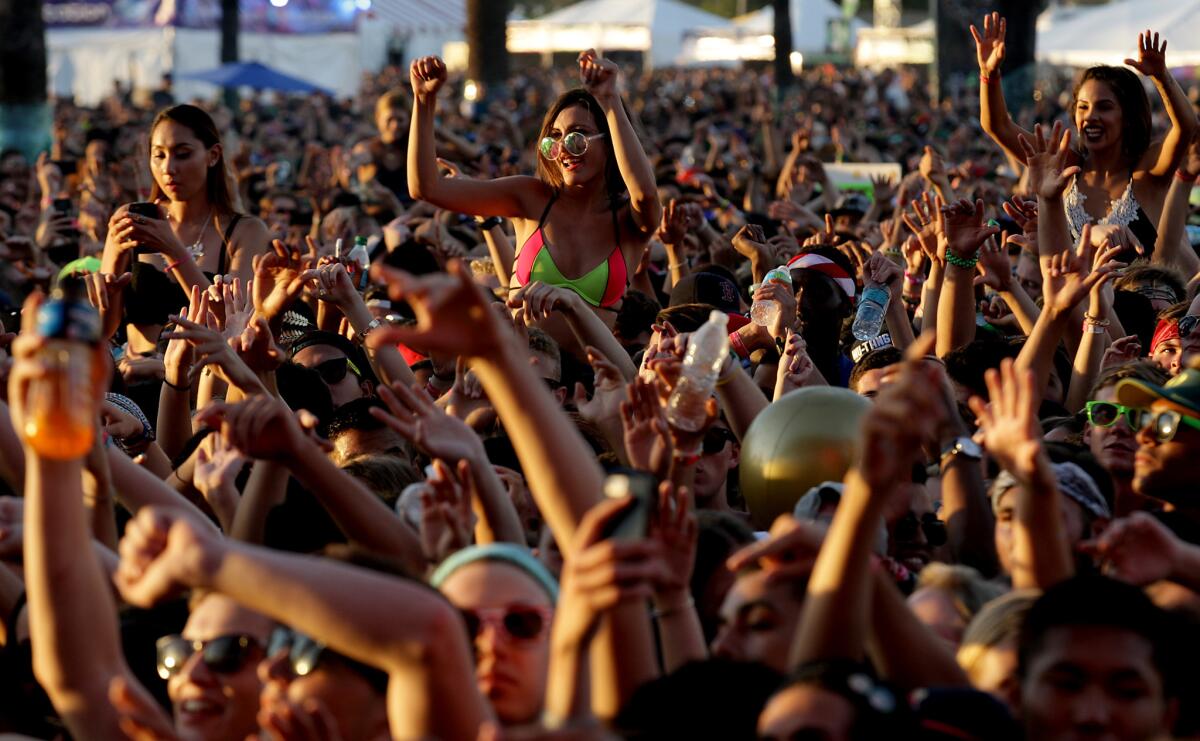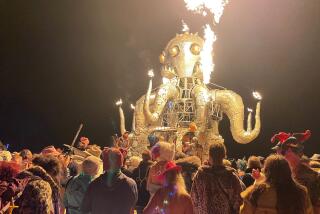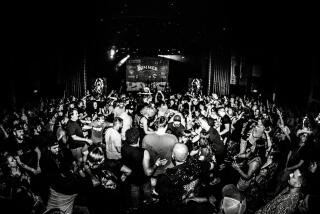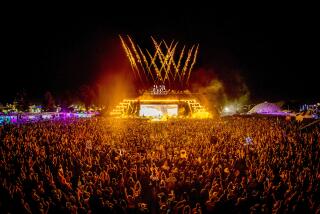Death of two women at Hard Summer rave rekindles festival drug concerns

Fans cheer a performance by Odesza during Hard Summer at the Fairplex in Pomona on Saturday.
The suspected overdose deaths of two young women who collapsed at the Hard Summer music festival at the Los Angeles County fairgrounds sparked new debate about whether authorities can do more to reduce drug-related problems at raves.
Although there are fewer raves in Los Angeles after a series of drug-related problems at the Los Angeles Memorial Coliseum, the events continue in arenas outside the city where they still draw big crowds.
Both women -- one 18 years old, the other 19 -- were found unresponsive Saturday at the Fairplex in Pomona, which is managed by the nonprofit Los Angeles County Fair Assn. on land mostly owned by the county.
County Supervisors Michael D. Antonovich and Hilda Solis said Sunday that they will ask for a full investigation to see whether the event was properly managed to ensure patrons’ safety.
“I am very concerned about these details and will request a full investigation,” Solis, whose Eastside district includes Pomona, said through a spokeswoman.
The annual two-day festival has grown in recent years. Attendance last year was 40,000 people per day; this year’s event expanded to 65,000 a day.
L.A.-based Hard Summer is considered the biggest music festival of its kind in the county.
Last year, 19-year-old Emily Tran of Anaheim was rushed to a South El Monte hospital from the festival, which was held at Whittier Narrows Recreation Area, a park managed by Los Angeles County. Tran died from acute intoxication of Ecstasy, according to coroner’s officials.
There has been much debate about whether public agencies should rent out space for raves given the drug problems.
When raves were held at the Coliseum, drug overdoses surged so much that local emergency rooms were overwhelmed with severely ill attendees, and doctors urged that such concerts no longer be held there. Los Angeles police warned that raves invite widespread Ecstasy use.
A 2013 Times investigation found that at least 14 people who attended raves run separately by two major Los Angeles rave organizers, Insomniac Inc. and Go Ventures Inc., had died from overdoses or in drug-related incidents since 2006.
Since then, drug-related incidents have led to the deaths of five more, including UC Irvine graduate Nicholas Austin Tom, 24, of San Francisco, who collapsed at Insomniac’s Electric Daisy Carnival at the Las Vegas Motor Speedway in June.
A sixth person, John Hoang Dinh Vo, 22, a UC Irvine biology senior, died in March after collapsing at Insomniac’s Beyond Wonderland rave at the San Manuel Amphitheater, a venue owned by San Bernardino County. The coroner has not yet released a cause of death.
Beverly Hills-based Live Nation Entertainment, one of the world’s largest concert and ticketing conglomerates, purchased Hard Events in 2012. It did not respond to inquiries about the deaths Sunday.
Fairplex officials said they had prepared for the rave but did not provide specifics.
Renee Hernandez, a Fairplex spokeswoman, said, “Any time we have a large event on our campus, we are aware of the risks. We have protocols in place and our event promoters supplement Fairplex medical and security staffing during highly popular events in consultation and coordination with community public safety leaders.
“We offer our condolences to the family of these young women, and the Fairplex takes every measure to ensure a safe and enjoyable experience at our events.”
Both women fell ill just minutes apart about 5 p.m. Saturday, county fire Inspector David Dantic said.
The 18-year-old was rushed to San Dimas Community Hospital and pronounced dead at 6:04 p.m.; the 19-year-old was sent to Pomona Valley Hospital Medical Center and declared dead at 8:40 p.m. Lt. Fred Corral, a coroner’s official, called the deaths “apparent drug overdoses,” and said autopsies will be conducted in the next few days.
Officials were still working to notify the women’s families. Their names were not released Sunday.
During the first day of the rave, 32 people were arrested, the majority for being drunk and disorderly, said Pomona Police Lt. Hector Rodriguez. By 6 p.m. Sunday, an additional 13 had been arrested, he said.
The deaths stunned some rave-goers, though many said drugs are fairly common at the event.
Ecstasy, an illegal hallucinogen, enhances the effect of raves’ beat-heavy music and pulsing lights, and is tied to rave culture. The drug is commonly seen as harmless, but doctors say it is dangerous and can cause body temperatures to soar to 108 degrees, causing organ failure, coma and death.
“I am surprised. It is a little shocking when anyone dies.... But people do drugs out here,” said Jackie Diaz, 19, of Irvine.
“It is unfortunate that this kind of tragedy happens. People get carried away,” added Oscar Mendez, 19. “People try to fit in and they don’t know their limits.”
Ernesto Lopez, 23, said the heat and crowded conditions combined with drugs and alcohol can take a physical toll.
“Some people can’t handle it,” he said. “You have to look out for people. In heat, some people pass out. With all those bodies, the heat and, whatever else, it hurts.”
Hard Summer used to be hosted at Los Angeles State Historic Park near Chinatown and downtown L.A., where attendees could take the light-rail Gold Line.
In Pomona -- about 30 miles east of downtown L.A. and near the county border -- fans have to drive home almost by default, or take ride-sharing services such as Uber, which charged 41/2 times the normal fare as the festival let out.
Hard’s closest-minded peer, the Electric Daisy Carnival, is famous for its seas of overheated young bodies splayed out in the rare shady areas where the 110-degree temperature is slightly alleviated.
The American rave scene has expanded dramatically in recent years. U.S. rave festivals have grown in capacity by 50% since 2007, according to the dance music trade group IMS.
Organizers of electronic music festivals have generally said they try to make their events safe and don’t want their attendees taking drugs. Those who attend should be on the lookout for anyone falling ill, they say.
--
richard.winton@latimes.com, ron.lin@latimes.com, august.brown @latimes.com
Times staff writer Lauren Raab contributed to this report.
More to Read
Sign up for Essential California
The most important California stories and recommendations in your inbox every morning.
You may occasionally receive promotional content from the Los Angeles Times.












